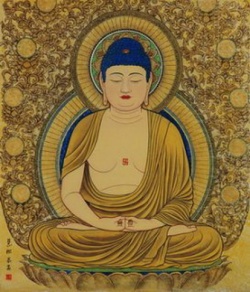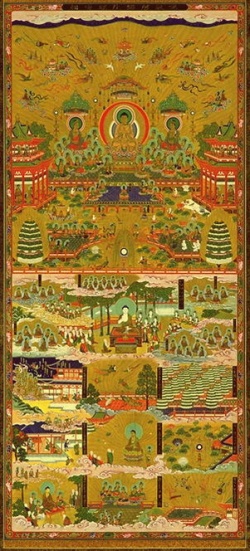What Is Pure Land Buddhism?
The Basics
What exactly is a "Pure land?" It's actually two things at once:
It is the realm of Purified Mind itself, our own Essential Enlightened Nature. The Mahavaipula-mahasmanipata Sutra states, "The triple worlds exist in the Mind. Why is that? One sees in one's Mind whatever one thinks of. It is our Mind that sees The Buddha. Our Mind becomes The Buddha. Our Mind is The Buddha; our Mind is the Tathagata."
It is a literal realm of Rebirth in which the impediments to cultivation are nonexistent, enabling one to purify one's Karma without hindrance.
These two aspects of the Pure land come about as the result of what is known as the Interpenetration of Phenomenon and Principle. This teaching points out the interdependent nature of the relative World and the true, underlying nature of that World, based on the teaching of One Mind. The Tang Dynasty master Yun-Ming Yen-Shou, who was a key figure in the synthesis of the
Ch'an and Pure land schools said, All things of Principle and Phenomenon are based on the Mind. From the perspective of Principle, a Sutra says, "Contemplating that all dharmas are made from the Mind, one accopmlishes a Body of Wisdom and becomes Enlightened without the help of others." This is an Insight into the True Mind as the fundamental through the contemplation of True Suchness. From the perspective of Phenomenon, a Sutra says, "The Mind is just like a skillful painter who is able to draw everything in the World. The five aggregates arise from the Mind. There is nothing that is not created from it." This perspective takes the rational cogitating Mind as fundamental through the conscious Mind.
The object of Pure Land Buddhism is the direct realization of the Purified Mind and our subsequent Rebirth into the Realm of Bliss. Our Purified Mind is the Pure land, and our True Nature is Amitabha Buddha.
The Tripod
Pure Land Buddhism rests on what is known as the Tripod:
Practice - Single-minded effort, using a variety of techniques such as visualization, Meditation and recitation, aimed at Buddha Remembrance Samadhi (Buddhanusmrti in Sanskrit, Nien-Fo in Chinese). Buddhanusmrti means "To stay mindful of The Buddha," and has been the central practice philosophy of Pure Land Buddhism since its inception.
Aspiration - The Vow to be reborn into the Pure land through realizing the Pure land which is one's True Mind.
Faith - Also known as "Serene Trust" in one's True Nature, which also means having that same Trust and confidence in the Compassion and Wisdom of Amitabha Buddha and all Buddhas. This includes the firm conviction that the Bodhisattva Vow made by all Buddhas to lead all Sentient beings to Enlightenment either has been or will be fulfilled.
The Buddha Amitabha
Amitabha BuddhaIn Buddhist cosmology, The Buddha known as Amitabha ("Boundless Light/Boundless Compassion"), also known as Amitayus ("Boundless Life/Boundless Wisdom"), presides over a Buddha-realm known as Sukhavati, the Pure land of Bliss. The
existence of this purified realm is the result of the accumulated Merit of the Bodhisattva Dharmakara who became The Buddha Amitabha after aeons of cultivation. Dharmakara vowed that when Buddhahood was attained, the resulting realm of existence would include the finest features of all the other Buddha-realms, making it easy for those reborn there to purify their past Karma.
The Vows
According to the Sutras, Bodhisattva Dharmakara made 48 vows regarding the nature of The Buddha-realm which would come into existence. Among these are four very crucial vows, the 18th, 19th, 20th and 22nd. These vows are enumerated in the Larger Sukhavati Sutra, one of the three main Pure land scriptures.
The 18th vow states that anyone who has vowed to be reborn into the Realm of Bliss and has dedicated their roots of Merit to this Rebirth will indeed be reborn there, even if this vow has been sincerely made as few as ten times.
The 19th vow states that Amitabha Buddha will appear at the moment of Death to one who cultivates Virtue, resolves to seek Awakening, and single-mindedly aspires to be reborn into the Realm of Bliss.
The 20th vow guarantees Rebirth into the Realm of Bliss for those who have cultivated Virtue, have sought Awakening, and have single-mindedly aspired to be reborn into this realm.
The 22nd vow states that once reborn into the Realm of Bliss, one may either complete the Bodhisattva Path and attain Perfect Full Awakening, or may take what are known as the Vows of Samanthabhadra, namely to follow the full Bodhisattva Path and to return to the cycle of Rebirth to assist all Sentient beings.
Other Key Concepts
The Existence of Many Buddhas. Shakyamuni, the historical Buddha of our age, is not the only Buddha to ever have existed. Indeed, all beings have the nature to become totally Awakened to the Truth of The Universe. One of the first Buddhas other than Shakyamuni to be mentioned in the Buddhist tradition was The Buddha Maitreya, the next Buddha who will appear in our own World-system which is known as the Saha World.
Merit and the Transference of Merit. There are a myriad of benefits to be derived from the non-attached practice of Wisdom and Compassion, including the Buddhist Precepts which are guidelines for Enlightened living. These benefits, or "Merit," may be accumulated and subsequently transferred to any or all Sentient beings for their benefit (transpersonal) or rededicated so as to transform them into benefits for one's self (personal).
The Existence of Buddha-Realms. Buddhas spread their influence over a system of worlds in which they teach Dharma and exert their benevolence. Shakyamuni is The Buddha of our own World system. Buddha-Realms may also be seen as the Realm of Mind.
The Bodhisattva Path. Bodhisattvas are "Enlightenment Beings" who are on the Path toward Nirvana, the end of all Suffering, the realm of Perfect Peace. Bodhisattvas work not only for their own Enlightenment, but also for the enlightenment of all Sentient beings. Once the Bodhisattva Path is begun, the Bodhisattva is instructed by a Buddha. Shakyamuni Buddha's teacher was The Buddha Dipamkara; Shakyamuni Buddha is the teacher of The Buddha to come, Maitreya. The Buddha Lokeshvararaja was the teacher of the Bodhisattva Dharmakara, who was to become The Buddha Amitabha.
One fact is undeniably clear: Pure land practice can accommodate people of any and all capacities. It utilizes practices which include Meditation, visualization, recitation, devotion and Sutra study, so one may choose a practice which is consistent with one's capacity and inclination. This is why Pure Land Buddhism is such a marvelous Path for those who are seeking Liberation in this modern age when there are so very many distractions and impediments to Enlightenment.

